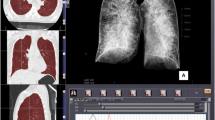Abstract
Purpose
This study evaluated the usefulness of multidetector computed tomography (MDCT) in the postmortem diagnosis of death by drowning in fresh water by measuring the difference of blood density within the cardiac chambers.
Materials and methods
Twenty-two corpses including six cases of fresh-water drowning (group A) and 16 deaths by other causes (group B), among which were also different forms of mechanical asphyxia other than drowning, underwent MDCT and conventional autopsy. Blood density within the right and left heart chambers, the aorta and the pulmonary trunk was measured and values compared between groups and within each group between heart chambers.
Results
Blood density in all cardiac chambers was lower in group A than in group B. The difference was statistically significant within the left atrium and ventricle and was significantly lower in the left than in the right heart chambers in group A only.
Conclusions
MDCT, together with conventional autopsy, may contribute to the diagnosis of drowning, by measuring blood density in the heart chambers.
Riassunto
Obiettivo
Valutare se l’impiego della tomografia computerizzata multistrato (TCMS) possa essere d’aiuto nella diagnosi di morte per annegamento in acqua dolce tramite misura della differenza di concentrazione ematica all’interno delle camere cardiache.
Materiali e metodi
Sono stati sottoposti a TCMS ed esame autoptico convenzionale 22 cadaveri, di cui 6 morti per annegamento in acqua dolce (gruppo A) e 16 per altre cause (gruppo B), tra le quali erano presenti anche asfissie meccaniche diverse dall’annegamento. è stata misurata la densità del sangue all’interno delle camere cardiache di destra e sinistra, dell’aorta e del tronco polmonare e confrontati i valori tra i due gruppi e all’interno di ogni gruppo tra le camere cardiache.
Risultati
La densità ematica all’interno di tutte le camere cardiache è risultata inferiore nel gruppo A rispetto al gruppo B. La differenza è risultata statisticamente significativa all’interno di atrio e ventricolo di sinistra. La densità ematica è risultata significativamente inferiore nelle camere cardiache di sinistra rispetto quelle di destra solo nel gruppo A.
Conclusioni
La TCMS può essere impiegata per la misura della densità ematica nelle camere cardiache per la diagnosi di morte da annegamento in acqua dolce in ausilio all’esame autoptico convenzionale.
Similar content being viewed by others
References/Bibliografia
Bolliger SA, Thali MJ, Ross S et al (2008) Virtual autopsy using imaging: bridging radiologic and forensic sciences. A review of the Virtopsy and similar projects. Eur Radiol 18:273–282
Dirnhofer R, Jackowski C, Vock P et al (2006) VIRTOPSY: minimally invasive, imaging-guided virtual autopsy. Radiographics 26:1305–1333
Christe A, Flach P, Ross S et al (2010) Clinical radiology and postmortem imaging (Virtopsy) are not the same: specific and unspecific postmortem signs. Leg Med (Tokyo) 12:215–222
Pomara C, Fineschi V, Scalzo G et al (2009) Virtopsy versus digital autopsy: virtuous autopsy. Radiol Med 114:1367–1382
Thali MJ, Yen K, Schweitzer W et al (2003) Virtopsy, a new imaging horizon in forensic pathology: virtual autopsy by postmortem multislice computed tomography (MSCT) and magnetic resonance imaging (MRI) — a feasibility study. J Forensic Sci 48:386–403
Thali MJ, Braun M, Buck U et al (2005) VIRTOPSY-scientific documentation, reconstruction and animation in forensic: individual and real 3D data based geometric approach including optical body/object surface and radiological CT/MRI scanning. J Forensic Sci 50:428–442
Piette MH, De Letter EA (2006) Drowning: still a difficult autopsy diagnosis. Forensic Sci Int 163:1–9
Modell JH (1993) Drowning. N Engl J Med 328:253–256
Giammona ST, Modell JH (1967) Drowning by total immersion. Effects on pulmonary surfactant of distilled water, isotonic saline, and sea water. Am J Dis Child 114:612–616
Saukko P, Knigh B (2004) Knight’s forensic pathology, 3rd edn. Arnold, pp 395–411
Payne-James J, Busuttil A, Smock W (2003) Forensic medicine — clinical and pathological aspects. GMM 249–257
de Boer J, Biewenga TJ, Kuipers HA et al (1970) The effects of aspirated and swallowed water in drowning: Sea water and fresh-water experiments on rats and dogs. Anesthesiology 32:51–59
Lunetta P (2005) Bodies found in water — epidemiological and medico-legal issues. Yliopistopaino, Helsinki
Pollanen MS (1998) Forensic diatomology and drowning. Elsevier
Levy AD, Harcke HT, Getz JM et al (2007) Virtual autopsy: two- and three-dimensional multidetector CT findings in drowning with autopsy comparison Radiology 243:862–868
Christe A, Aghayev E, Jackowski C et al (2008) Drowning — postmortem imaging findings by computed tomography. Eur Radiol 18:283–290
Jeanmonod R, Staub CH, Mermillod B (1992) The reliability of cardiac haemodilution as a diagnostic test of drowning. Forensic Sci Int 52:171–180
Author information
Authors and Affiliations
Corresponding author
Rights and permissions
About this article
Cite this article
Ambrosetti, M.C., Barbiani, C., El-Dalati, G. et al. Virtual autopsy using multislice computed tomography in forensic medical diagnosis of drowning. Radiol med 118, 679–687 (2013). https://doi.org/10.1007/s11547-012-0910-y
Received:
Accepted:
Published:
Issue Date:
DOI: https://doi.org/10.1007/s11547-012-0910-y




